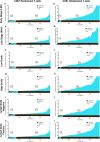Keratin 17 modulates the immune topography of pancreatic cancer
- PMID: 38730319
- PMCID: PMC11087249
- DOI: 10.1186/s12967-024-05252-1
Keratin 17 modulates the immune topography of pancreatic cancer
Abstract
Background: The immune microenvironment impacts tumor growth, invasion, metastasis, and patient survival and may provide opportunities for therapeutic intervention in pancreatic ductal adenocarcinoma (PDAC). Although never studied as a potential modulator of the immune response in most cancers, Keratin 17 (K17), a biomarker of the most aggressive (basal) molecular subtype of PDAC, is intimately involved in the histogenesis of the immune response in psoriasis, basal cell carcinoma, and cervical squamous cell carcinoma. Thus, we hypothesized that K17 expression could also impact the immune cell response in PDAC, and that uncovering this relationship could provide insight to guide the development of immunotherapeutic opportunities to extend patient survival.
Methods: Multiplex immunohistochemistry (mIHC) and automated image analysis based on novel computational imaging technology were used to decipher the abundance and spatial distribution of T cells, macrophages, and tumor cells, relative to K17 expression in 235 PDACs.
Results: K17 expression had profound effects on the exclusion of intratumoral CD8+ T cells and was also associated with decreased numbers of peritumoral CD8+ T cells, CD16+ macrophages, and CD163+ macrophages (p < 0.0001). The differences in the intratumor and peritumoral CD8+ T cell abundance were not impacted by neoadjuvant therapy, tumor stage, grade, lymph node status, histologic subtype, nor KRAS, p53, SMAD4, or CDKN2A mutations.
Conclusions: Thus, K17 expression correlates with major differences in the immune microenvironment that are independent of any tested clinicopathologic or tumor intrinsic variables, suggesting that targeting K17-mediated immune effects on the immune system could restore the innate immunologic response to PDAC and might provide novel opportunities to restore immunotherapeutic approaches for this most deadly form of cancer.
Keywords: Cancer biomarker; Cancer immunology; Digital pathology; Immune microenvironment; Keratin 17; Multiplexed immunohistochemistry; Pancreatic ductal adenocarcinoma.
© 2024. The Author(s).
Conflict of interest statement
KRS and LEH are consultants to KDx Diagnostics Inc. EB is an employee of Perthera and owns stock in the company. EFP has received compensation as an officer of Perthera, Inc. and owns stock in the company. He has also consulted for Theralink Technologies, Inc. and received compensation as Chair of their Science Advisory Board and owns stock in the company. Other authors report no competing interests with the current study.
Figures





Update of
-
Keratin 17 modulates the immune topography of pancreatic cancer.Res Sq [Preprint]. 2024 Feb 20:rs.3.rs-3886691. doi: 10.21203/rs.3.rs-3886691/v1. Res Sq. 2024. Update in: J Transl Med. 2024 May 10;22(1):443. doi: 10.1186/s12967-024-05252-1. PMID: 38464123 Free PMC article. Updated. Preprint.
References
-
- Achanta R, Shaji A, Smith K, Lucchi A, Fua P, Süsstrunk S. SLIC superpixels compared to stateof-the-art superpixel methods. IEEE Trans Pattern Anal Mach Intell. 2012;34(11):2274–82. 10.1109/TPAMI.2012.120. - PubMed
-
- Adsay V, Logani S, Sarkar F, Crissman J, Vaitkevicius V. Foamy gland pattern of pancreatic ductal adenocarcinoma: a deceptively benign-appearing variant. Am J Surg Pathol. 2000;24(4):493–504. 10.1097/00000478-200004000-00003. - PubMed
-
- Amin MB, Greene FL, Edge SB, Compton CC, Gershenwald JE, Brookland RK, Meyer L, Gress DM, Byrd DR, Winchester DP. The eighth edition AJCC cancer staging manual: continuing to build a bridge from a population-based to a more “personalized” approach to cancer staging. CA Cancer J Clin. 2017;67(2):93–99. doi: 10.3322/CAAC.21388. - DOI - PubMed
-
- Bailey P, Chang DK, Forget MA, Lucas FAS, Alvarez HA, Haymaker C, Chattopadhyay C, Kim SH, Ekmekcioglu S, Grimm EA, Biankin AV, Hwu P, Maitra A, Roszik J. Exploiting the neoantigen landscape for immunotherapy of pancreatic ductal adenocarcinoma. Sci Rep. 2016;6(1):1–8. doi: 10.1038/srep35848. - DOI - PMC - PubMed
Publication types
MeSH terms
Substances
Grants and funding
LinkOut - more resources
Full Text Sources
Medical
Molecular Biology Databases
Research Materials
Miscellaneous

